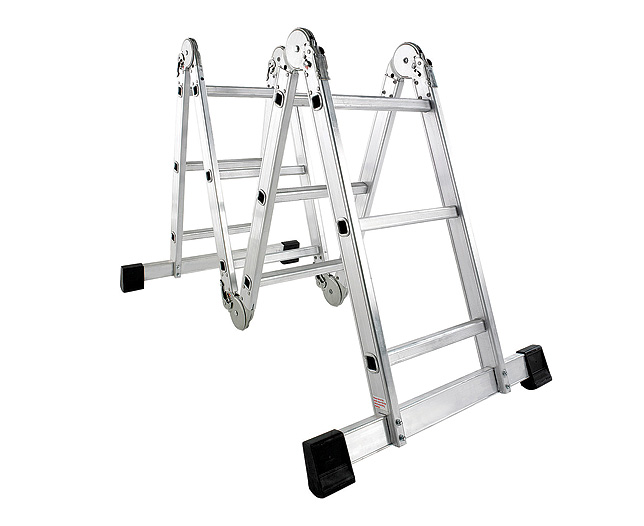

Access might be improved if the cleats above the landing are removed to allow walk-through.
SUPPORTED SCAFFOLD LADDER PORTABLE
manufactured portable ladder) (4) and that it is secured in place. (3) looks like it’s at the proper angle (you may want to have them look up the difference in angle for job-made vs. SUBPARTS X & L Ladders and Scaffolds 10 Access to the Roof The Job-Made Ladder What is done right here? What could be done better? Trainer's Notes: The participants should be able to point out that: (1) the ladder cleats are properly installed with blocks for support (2) the ladder is long enough with 3 foot extension. Ask for opinions of the situation at right – is this ladder weakened? Is there a hazard? What would (should) an OSHA inspector do? Is this a citation? Is there a hazard created here?ġ1 Access to the Roof The Job-Made Ladder Can they be fixed? Trainer's Notes: Emphasize that the only acceptable ‘fix’ would be as approved by the manufacturer. SUBPARTS X & L Ladders and Scaffolds 9 Defective Ladders Ladders must be inspected by a Competent Person.
SUPPORTED SCAFFOLD LADDER HOW TO
Has anyone ever read it? Why is the 4:1 ladder slope the safest? Can anyone demonstrate how to measure that slope when setting up a ladder? Maximum extension not exceeded Bottom secured 1/4th of Working Lengthġ0 Is this a citation? Is there a hazard created here? SUBPARTS Ladders and Scaffolds 8 X & L Proper Ladder Set-Up 3 foot extension above landing Top end secured Trainer's Notes: Remind the group that all of the ladder set up and use precautions are on the sticker on the side rail of every ladder they will see. Use ONLY as intended by the manufacturer! Trainer's Notes: Ask the group: Just why is it that we all misuse and abuse stepladders so much? (See stupid ladder tricks in subsequent slides.)ĩ Proper Ladder Set-Up Ladders and Scaffolds Stepladders cannot be used leaned against a vertical wall, they must be opened and used as intended. SUBPARTS Ladders and Scaffolds 7 X & L Basic Stepladder Use Do not use top step on stepladder. Trainer's Notes:Ĩ Basic Stepladder Use Do not use top step on stepladder. SUBPARTS Ladders and Scaffolds 6 X & L Basic Ladder Use Don’t move a ladder that is occupied. Trainer's Notes: If job-made ladders are used they must meet OSHA specifications – also in Subpart X.ħ Basic Ladder Use Don’t move a ladder that is occupied. Cannot work off ladder unless 3-point contact is maintained. SUBPARTS Ladders and Scaffolds 5 X & L Basic Ladder Use Use only for intended purpose.

Trainer's Notes: Stress the potential for injury on a job site where there is a lot of climbing without proper ladders, stairs and scaffolding.Ħ Basic Ladder Use Use only for intended purpose. At least one access point between levels must be clear at all times. Two or more ladders or double-cleated ladder if more than 25 employees. SUBPARTS Ladders and Scaffolds 4 X & L Access to the Work Level If elevation change is 19 inches or more and there is no ramp, runway, slope or hoist: Employer must provide stairway & ladders prior to work at elevated areas. Trainers Notes: In the roofing industry, ladders ranked #3 in OSHA citations for 1999 (SIC 1761). Most deaths from falls off ladders happen from 10 feet or lower. SUBPARTS Ladders and Scaffolds 3 X & L Ladder Hazards Ladders not secured Ladder not extended 3 feet above landing Defective ladders Ladders within 10 feet of power lines Fixed ladders without fall protection 12% of OSHA citations for physical hazards are for unsafe ladders or stairs. Facilitate discussion of ladders and scaffolds in roofing since this is an important area as it relates to potential for fall injuries. Trainer's Notes: Ask participants to relate some of their experiences. Know the basics of Subpart L – Scaffolds. Understand safe erection and use of scaffolding. Know how to inspect a ladder for defects. SUBPARTS Ladders and Scaffolds 2 X & L Training Objectives After completing this section you will: Understand safe ladder placement & use.

SUBPARTS X & L Ladders and Scaffolds 1 References 29 CFR, Subpart X - Ladders 29 CFR, Subpart L - Scaffolds American National Standards Institute (ANSI) Trainer's Notes: Manufacturer’s literature is always useful to make your points about intended use, load ratings and so on…ģ Training Objectives After completing this section you will: Video Options: “Scaffold Safety: From the Ground Up, Parts 1 & 2 (NRCA) “Scaffold Safety: From the Ground Up, Part 3, Aerial Lifts, Forklifts, and Fork-Mounted Platforms” (NRCA)Ģ References. Take note of scaffolds in the neighborhood that the participants may be familiar with to talk about.

New England Roofing Industry Partnership Ladders and Scaffolds Trainer's Notes: Duration: One Hour Training Aids: Always good to have a stepladder and or ladder to refer to during discussion.


 0 kommentar(er)
0 kommentar(er)
